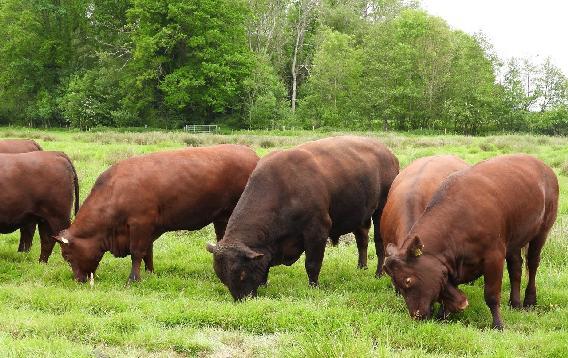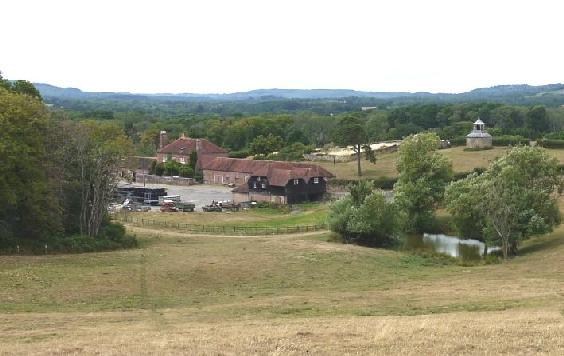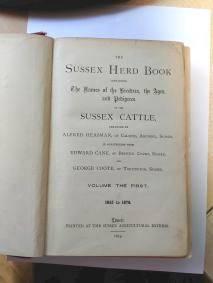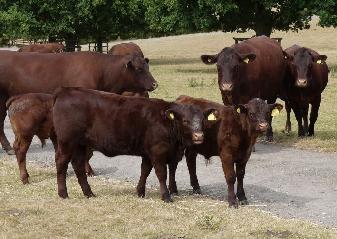
6 minute read
HistoricHerdthe LeconfieldEstateCattle
The Leconfield Estate cattle. By Keir Hartley
They stand on a small rise in the pasture, observing our car which has just drawn up. Thirty or so cows, calves, heifers and a single massive bull. Deep red all over, against the green grass and the deeper green of Black Down behind them. These are Pedigree Sussex cattle, part of the Petworth herd. And I am on the Leconfield Estate just north of Petworth on a warm summer afternoon. I am about to learn not only about the cattle, part of our Sussex heritage. But also about one of the most remarkable Englishmen of the eighteenth century, and his role in transforming the world. It’s good to be cautious when you approach herds with calves and John Giffin, Director of Leconfield Farms Ltd, asks us to wait in the car until the animals get used to us. John has worked here for 57 years and has spearheaded the development of the Sussex Breed since the 1970s. The herd, about twenty yards away look back at us as our second car rolls up the slope. Fred Lucas, Managing Agent, and Farm Manager Scott Bushby join us, along with Scott’s son Jacob. The animals in front of us are part of a working herd. The Leconfield Estate has about 150, including 50 females with calves, heifers and 3 stock bulls. “It’s a closed herd for females” Scott explains” the trick is to buy a bull when you don’t need one, as demand fluctuates.” They graze on 200 acres of pasture at Stag Park and 75 acres of water meadows, alongside a flock of sheep. Overall, there are about 2000 Sussex cattle in herds across southern England. One noteworthy group grazes at Windsor, as property of His Majesty the King, and they contain Petworth genes. Unbroken line since 1780s John explains why these animals are truly special “We have had an unbroken line here at Leconfield since the 1780s.We’re not quite sure when the herd was established, but it was here in 1782 when the 3rd Earl of Egremont cleared and drained the land to create the farmhouse
Advertisement
Photo credit: Andrew Thompson and model farmstead. The herd is said to come from imported Indian cattle. They were first used as oxen to help clear the forest. We still sometimes find their old clay shoes.” The Petworth and Leconfield Estates were once synonymous. Petworth House was gifted to the nation in 1947, but the Leconfield Estate, property of the current Lord Egremont, still owns most of the land in the area. George O’Brien Wyndham, 3rd Earl of Egremont (1751-1837) was a remarkable figure and deserves to be better remembered. He was a patron of the arts, counting such notable figures as JMW Turner among his friends. He was pioneer of transport, organising programmes of canal cutting. He was involved in politics, as a Whig, and even raised regiments for home defence during the revolutionary wars with France. But his true importance was as a pioneer of the most advanced agricultural techniques of the time. His Estate was at the forefront of the Agricultural Revolution. A beacon of progress Before 1700 agricultural progress had been slow for centuries. By 1800 the work of pioneers like Tull, Townshend and others had transformed everything. There were changes in crop rotation, machinery, and extensive breeding programmes for all kinds of animals, such as pigs, sheep and cattle. As an enlightened aristocrat, the 3rd Earl decided that he would put the new ideas into practice. He would create a farm that would be a

beacon of progressive techniques for the whole world to copy. It would showcase the very latest ideas in land management, food production and buildings. A kind of eighteenth-century Silicon Valley in Sussex. So, in that single year of 1782 the land was cleared and drained. The centre of the farm was moved to take advantage of a spring. A whole cluster of buildings was put up including farmhouse and barns. They exist to this day, as we’ll see. Once the work of the oxen was complete, the 3rd Earl turned the herd over to beef, as it still is. His achievements were carefully noted by Arthur Young, a famous chronicler of the agricultural revolution, who praised them in his 1793 work The Agriculture of West Sussex. And the special qualities of the Sussex pedigree would last. The Sussex Herd book breed is referenced again and again in herd books throughout the nineteenth century, its meat being especially noted.


The farmhouse and barns today
Still relevant Sussex cattle are an historic breed, hardier than many modern breeds and can thrive on rougher pasture, making them more economic in an extensive system or as a conservation grazing herd. Because they mature quickly, they produce less methane-another contribution to reducing global warming. As issues like food security move up the agenda, so too do those of locally and sustainably produced food. This piece of heritage is part of the future. We leave the herd to board the cars and, after a bumpy ride (this is a working farm, not a
DIRECT BLINDS
• Vertical,
Venetian,
Wood, Roller,
Pleated
• Awning & Canopies 18 years experience • Approved Supplier for
Caribbean Awnings &
Canopies • Specialists in Conservatory Blinds & Inshade sails Perfect fit blinds
• Full range of shutters expertly fitted by our
City and Guilds qualified carpenter and joiner
Home visits available
Unit 2 Northbrook Business Park, Northbrook Road, Worthing, BN14 8PQ 01903 823 803
theme park) we arrive at a cluster of buildings largely unchanged since the eighteenth century. Most, including the farmstead are in the typical red brick of that era. But the real “hidden gem” is the barn, which stands as the 3rd Earl had it built. We step inside and peer up at an intricately constructed framework of timber beams and uprights. A tribute to the skills of the craftsmen who made it, lofty and intricate like a medieval cathedral. Finding the Balance in the spirit of its founder, Leconfield Farms still looks to the future and the role it will play in food production and conservation. It’s a work in progress, as Fred notes “finding the balance between both environmental and productive sustainability-who knows where that balance will be?” John welcomes the growing emphasis on sourcing: “People are more aware of food miles and where their food comes from-there is a strong demand for local beef” he explains. Meanwhile, the Estate cooperates closely with conservation bodies in a range of projects for all sorts of local environmental enhancement It's time to leave, and we take our last photographs. “There’s so much history” muses Fred “The estate has been in the same family’s ownership for about 900 years. We’re stewards really, in custody of the Estate for a generation before passing it on in, hopefully, an improved condition” And they love it. “Getting up each day with a general enthusiasm to care for the livestock you’re entrusted with. It’s not a job, it’s a way of life” says Scott. “It’s a privilege” says John. Sometimes there’s a clash between defenders of “heritage” and modernists, who allege it’s stopping us from looking to the future. Our visit has made me think about these things in a different way. Yes, this place is as much part of Sussex Heritage as the Seven Sisters or Arundel Castle. But the things preserved here are ideas of the future-and there is plenty of potential still. Our grateful thanks to the management of the Leconfield estate and The Sussex Cattle Society.






